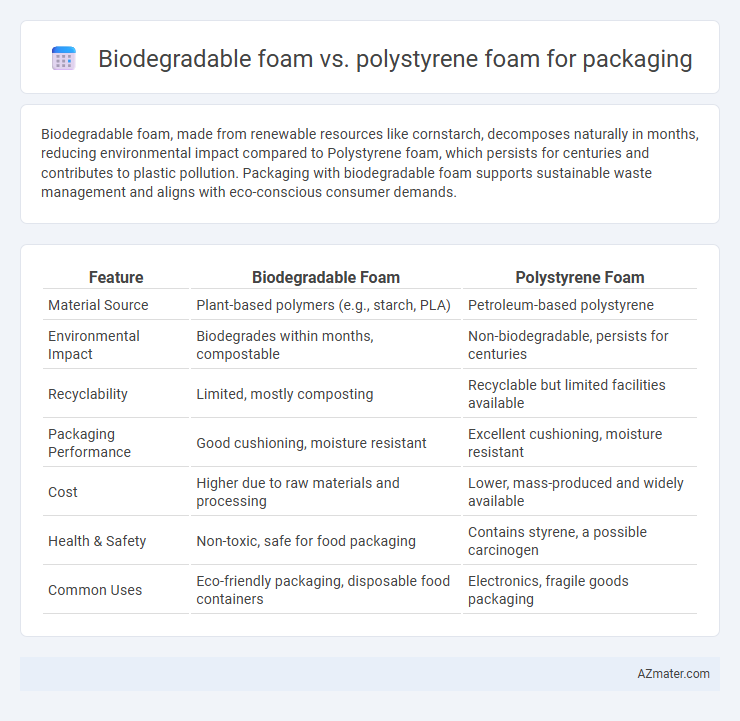Biodegradable foam, made from renewable resources like cornstarch, decomposes naturally in months, reducing environmental impact compared to Polystyrene foam, which persists for centuries and contributes to plastic pollution. Packaging with biodegradable foam supports sustainable waste management and aligns with eco-conscious consumer demands.
Table of Comparison
| Feature | Biodegradable Foam | Polystyrene Foam |
|---|---|---|
| Material Source | Plant-based polymers (e.g., starch, PLA) | Petroleum-based polystyrene |
| Environmental Impact | Biodegrades within months, compostable | Non-biodegradable, persists for centuries |
| Recyclability | Limited, mostly composting | Recyclable but limited facilities available |
| Packaging Performance | Good cushioning, moisture resistant | Excellent cushioning, moisture resistant |
| Cost | Higher due to raw materials and processing | Lower, mass-produced and widely available |
| Health & Safety | Non-toxic, safe for food packaging | Contains styrene, a possible carcinogen |
| Common Uses | Eco-friendly packaging, disposable food containers | Electronics, fragile goods packaging |
Introduction to Foam Packaging Solutions
Biodegradable foam offers an eco-friendly alternative to traditional polystyrene foam in packaging applications by breaking down naturally and reducing landfill waste. Polystyrene foam, widely used for its lightweight and insulating properties, poses significant environmental challenges due to its non-biodegradable nature and persistence in ecosystems. Shifting to biodegradable foam aligns with sustainability goals and regulatory pressures, driving innovation in packaging solutions that minimize environmental impact without compromising protective performance.
What Is Biodegradable Foam?
Biodegradable foam is an eco-friendly packaging material designed to break down naturally through microbial activity, reducing environmental impact compared to traditional polystyrene foam. Made from renewable resources such as starches, cellulose, or polylactic acid (PLA), it decomposes within months under composting conditions, unlike polystyrene foam which can persist for hundreds of years. This sustainable alternative offers effective cushioning and insulation while minimizing landfill waste and pollution.
Understanding Polystyrene Foam
Polystyrene foam, widely used in packaging due to its lightweight and shock-absorbing properties, is a petroleum-based plastic that poses significant environmental challenges because it is non-biodegradable and difficult to recycle. Biodegradable foam alternatives, often made from renewable resources like cornstarch or plant fibers, decompose naturally and reduce landfill waste, offering a more sustainable solution. Understanding the chemical composition and environmental impact of polystyrene foam highlights the urgent need to transition toward eco-friendly packaging materials.
Material Composition and Production
Biodegradable foam is primarily made from renewable resources such as cornstarch, sugarcane, or other plant-based materials, offering an eco-friendly alternative to traditional packaging. Polystyrene foam, composed of petroleum-based polystyrene, involves a chemical polymerization process that generates a lightweight and insulating material but contributes significantly to environmental pollution due to its non-biodegradability. Production of biodegradable foam typically requires less energy and results in lower carbon emissions, enhancing its sustainability profile compared to the energy-intensive manufacturing of polystyrene foam.
Environmental Impact Comparison
Biodegradable foam, made from renewable resources like cornstarch or sugarcane, breaks down naturally within months, reducing landfill accumulation and minimizing toxic leachates. Polystyrene foam is non-biodegradable, persisting for hundreds of years and contributing significantly to plastic pollution and marine ecosystem damage. The environmental impact of biodegradable foam is substantially lower, as it supports waste composting initiatives and decreases carbon footprint compared to fossil fuel-based polystyrene foam production and disposal.
Degradation and Disposal Methods
Biodegradable foam decomposes through natural microbial activity within months, reducing environmental impact and landfill accumulation compared to polystyrene foam, which can persist for hundreds of years due to its chemical resistance and stability. Disposal of biodegradable foam often involves composting or anaerobic digestion, enabling organic breakdown, whereas polystyrene foam typically requires specialized recycling facilities or ends up in landfills and oceans, contributing to long-term pollution. Choosing biodegradable foam enhances sustainable packaging by facilitating eco-friendly degradation and minimizing hazardous waste.
Performance in Packaging Applications
Biodegradable foam offers excellent cushioning and shock absorption comparable to polystyrene foam, making it a reliable choice for protecting fragile items during transit. Polystyrene foam is lightweight and has superior water resistance, contributing to its durability in various packaging applications. However, biodegradable foam excels in environmental impact, breaking down naturally without leaving harmful residues, which is increasingly preferred in sustainable packaging solutions.
Cost and Availability Analysis
Biodegradable foam typically incurs higher production costs compared to polystyrene foam due to the use of renewable materials and specialized manufacturing processes, impacting its overall market price. Polystyrene foam remains widely available and cost-effective, benefiting from established supply chains and mass production efficiencies, making it a preferred choice for low-budget packaging solutions. However, the growing demand for sustainable packaging is gradually increasing the availability and cost competitiveness of biodegradable foam in various industries.
Regulatory and Market Trends
Biodegradable foam packaging is gaining regulatory favor due to increasing environmental legislation, such as bans on single-use plastics and stricter waste management policies in the EU and North America. Market trends indicate a growing consumer demand for sustainable packaging solutions, driving companies to adopt biodegradable alternatives over traditional polystyrene foam, which faces restrictions owing to its non-biodegradable nature and environmental impact. The shift is reinforced by certifications and incentives supporting eco-friendly materials, accelerating the decline in polystyrene foam's market share within packaging industries.
Choosing the Right Foam for Packaging Needs
Biodegradable foam, made from renewable materials like starch or plant fibers, offers an eco-friendly alternative to traditional polystyrene foam, which is petroleum-based and non-biodegradable. Choosing the right foam depends on factors such as product fragility, environmental impact, cost considerations, and regulatory requirements for sustainability. Biodegradable foam excels in reducing landfill waste and meeting green packaging standards, while polystyrene foam provides superior cushioning and moisture resistance for sensitive electronics or perishable goods.

Infographic: Biodegradable foam vs Polystyrene foam for Packaging
 azmater.com
azmater.com